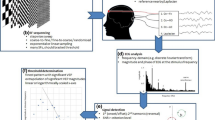Abstract
Purpose
To introduce a method for improvement of multifocal VEP (mfVEP) recordings by prediction of waveforms at multiple positions on the surface of the skull.
Methods
Fifteen healthy participants (mean age 24 ± 3.8 years) underwent mfVEP recordings from 3 surface positions. Two methods of a best-of-mfVEP approach were used and compared. In the first, a standard procedure, further data from 3 calculated channels were used. In the second approach, mfVEPs were obtained by using data derived from 40 virtual electrode positions on the basis of predictions from dipole source calculations.
Results
The mean signal-to-noise ratios (SNRs) of the best-of-mfVEPs of both methods were compared. The SNR was significantly higher for mfVEP data using additional virtual recordings revealed by dipole source determination (2.87 vs. 3.36; P < 0.035).
Conclusion
We conclude that multichannel prediction of mfVEP responses based on dipole source calculation significantly improves the quality of the examination results compared with the currently prevalent standard method.




Similar content being viewed by others
References
Baseler HA, Sutter EE, Klein SA, Carney T. The topography of visual evoked response properties across the visual field. Electroencephalogr Clin Neurophysiol. 1994;90:65–81.
Klistorner A, Graham SL. Objective perimetry in glaucoma. Ophthalmology. 2000;107:2283–99.
Hood DC, Zhang X, Hong JE, Chen CS. Quantifying the benefits of additional channels of multifocal VEP recording. Doc Ophthalmol. 2002;104:303–20.
Mazinani BA, Waberski TD, van Ooyen A, Walter P. Prediction of visual evoked potentials at any surface location from a set of three recording electrodes. Doc Ophthalmol. 2008;116:207–16.
Klem GH, Luders HO, Jasper HH, Elger C. The ten-twenty electrode system of the International Federation. The International Federation of Clinical Neurophysiology. Electroencephalogr Clin Neurophysiol Suppl. 1999;52:3–6.
Yang EB, Hood DC, Rodarte C, Zhang X, Odel JG, Behrens MM. Improvement in conduction velocity after optic neuritis measured with the multifocal VEP. Invest Ophthalmol Vis Sci. 2007;48:692–8.
Thienprasiddhi P, Greenstein VC, Chu DH, Liebmann JM, Ritch R, Hood DC. Detecting early functional damage in glaucoma suspect and ocular hypertensive patients with the multifocal VEP technique. J Glaucoma. 2006;15:321–7.
Hood DC, Odel JG, Winn BJ. The multifocal visual evoked potential. J Neuroophthalmol. 2003;23:279–89.
Hoffmann MB, Straube S, Bach M. Pattern-onset stimulation boosts central multifocal VEP responses. J Vis. 2003;3:432–9.
Fortune B, Demirel S, Zhang X, Hood DC, Patterson E, Jamil A, et al. Comparing multifocal VEP and standard automated perimetry in high-risk ocular hypertension and early glaucoma. Invest Ophthalmol Vis Sci. 2007;48:1173–80.
Zhang X, Hood DC, Chen CS, Hong JE. A signal-to-noise analysis of multifocal VEP responses: an objective definition for poor records. Doc Ophthalmol. 2002;104:287–302.
Author information
Authors and Affiliations
Corresponding author
About this article
Cite this article
Mazinani, B.A.E., Waberski, T.D., Weinberger, A.W.A. et al. Improving the quality of multifocal visual evoked potential results by calculating multiple virtual channels. Jpn J Ophthalmol 55, 396–400 (2011). https://doi.org/10.1007/s10384-011-0040-4
Received:
Accepted:
Published:
Issue Date:
DOI: https://doi.org/10.1007/s10384-011-0040-4




